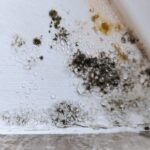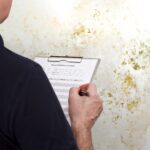How to Prevent Mold in Your Home This Holidays

The good news is, that preventing mold is simple and can help keep your home healthy and comfortable. A few easy steps, like controlling humidity, improving ventilation, fixing leaks, and cleaning regularly, can effectively prevent mold before it starts. Taking these actions will protect your home and keep your family safe.

What is Mold?
Mold is a type of fungus that grows in damp, warm areas. It spreads through tiny spores that float around in the air. These spores are usually harmless in small amounts, but when they land on wet surfaces, they can grow into mold. Left unchecked, mold can damage your home and even affect your health.
How Does Mold Grow?
Mold needs three things to grow: moisture, warmth, and a surface to stick to. When all these conditions come together, mold can start growing in just 24 to 48 hours. Things like leaky pipes, condensation on windows, or humidity in rooms like bathrooms can provide the moisture mold needs to develop.
What Causes Mold?
- Excess moisture or humidity: High humidity, especially in places like bathrooms and basements, creates the perfect setting for mold.
- Leaks: A leaking roof, cracked foundation, or even small plumbing problems can cause hidden moisture, which mold loves.
- Poor ventilation: If there’s not enough airflow, moisture can get trapped, and mold can spread quickly.
Where Mold Grows Most Often:
- Bathrooms: Showers, tubs, and sinks are common places for mold to grow because of the moisture and humidity.
- Basements and crawl spaces: These areas are often damp due to poor drainage or moisture from the ground.
- Kitchens: The steam from cooking and washing dishes creates moisture that can lead to mold.
- Attics: Poor ventilation, leaks, or humidity can make attics a common spot for mold.
Knowing how and why mold grows is the first step to preventing it. By controlling moisture and improving airflow, you can stop mold before it has a chance to spread.

Keep Humidity Under Control to Prevent Mold
Managing humidity in your home is one of the best ways to keep mold from taking over. Mold thrives in damp conditions, so keeping the humidity between 30% and 50% can help protect your space and make it more comfortable to live in.
Simple Ways to Manage Humidity
- Check Humidity Levels Regularly
A hygrometer is an easy tool that shows how humid your home is. Keep an eye on it so you know when adjustments are needed. - Use Products to Absorb Moisture
In places like closets, bathrooms, or basements, moisture absorbers or silica gel packs can help reduce dampness. - Clean Up Moisture Right Away
Don’t let spills or condensation sit for too long. Even a small puddle or damp spot can encourage mold if left alone.
Make the Most of Dehumidifiers and Air Conditioners
Dehumidifiers and air conditioners are great for keeping humidity under control, but here are a few tips to ensure they work well:
- Close Doors and Windows
Keep doors and windows shut while using these devices so they don’t have to work harder by pulling in outside moisture. - Place Your Dehumidifier in the Right Spot
Position the dehumidifier in the middle of the room or somewhere with good airflow. Avoid placing it too close to walls or furniture, as that can block vents and reduce efficiency.
Taking these simple steps can help you keep your home dry, comfortable, and free from mold.
Ventilation Tips to Prevent Mold
Good airflow is one of the easiest ways to keep mold from taking over your home. Without proper ventilation, moisture gets trapped, creating the perfect conditions for mold to grow. Here’s how you can keep your home fresh and dry:
Simple Ways to Improve Airflow
- Turn on ceiling fans: Ceiling fans aren’t just for cooling down a room. They help air circulate, reducing damp, humid spots where mold can thrive.
- Don’t overcrowd storage spaces: Packed closets and storage areas trap moisture. Try to space things out, and use plastic bins instead of cardboard boxes to keep mold away.
Tips for Bathrooms and Kitchens
- Leave the shower open: After you’re done showering, leave the curtain or door open so everything dries faster. This simple habit can help reduce moisture buildup.
- Ventilate while cooking: When boiling water or cooking for a while, use the exhaust fan or crack open a window. Steam can easily turn your kitchen into a humid zone, so letting it out is key.
Other Ventilation Ideas
- Add vents where they’re needed: Places like attics and crawl spaces can trap moisture. Adding vents will help air move and keep these spaces dry.
- Keep air ducts clean: Dust and debris can clog air ducts, making it harder for air to flow. Regularly cleaning your HVAC system helps keep the air moving and reduces the chance of mold.

Simple Ways to Prevent Leaks and Mold
Leaks are one of the main reasons mold shows up in your home. Even tiny leaks can create the perfect spot for mold to grow if they’re ignored. Finding and fixing leaks early can save you money, time, and stress. Here’s what you can do:
How to Spot Leaks
- Look at your gutters and downspouts
If gutters are clogged or damaged, water can pool around your home’s foundation, which might lead to leaks. Clean them regularly to keep water flowing away from your house. - Pay attention to your water bill
A sudden jump in your water bill could mean there’s a hidden plumbing leak. Check it out quickly to prevent bigger issues.
How to Fix Leaks
- Check your roof
Missing or broken shingles can let water seep in, especially during storms. Inspect your roof now and then and replace any damaged shingles. - Wrap your pipes
In colder months, pipes can collect condensation, which creates damp spots that mold loves. Wrapping your pipes with insulation can stop this.
Seal Up Windows and Doors
- Upgrade to better windows
Double-paned or storm windows can help reduce moisture, especially during colder weather when condensation is more common. - Seal any drafts
On a windy day, hold a candle near your windows and doors. If the flame flickers, there’s probably a gap where air and moisture can sneak in. Use caulk or weather-stripping to seal those gaps.
Cleaning Tips to Prevent Mold in Your Home
Mold can be a hassle, but with regular cleaning, you can stop it before it starts. Here are some easy habits to help keep mold out of your home:
Simple Cleaning Habits
- Wash items that trap moisture: Shower curtains, bath mats, and kitchen sponges soak up water and attract mold. Wash them often or replace them to keep mold away.
- Scrub grout and caulk: Mold loves to grow in grout between tiles and along caulk lines, especially in bathrooms and kitchens. Scrub them with a vinegar-water mix to prevent mold from spreading.
Keep Appliances Mold-Free
- Dry your washing machine: The rubber seals on front-load washers can trap moisture, making them a prime spot for mold. After each use, leave the door open and wipe down the seals to keep them dry.
- Check drip pans: Drip pans in your fridge or air conditioner collect water and can easily grow mold. Empty and dry them regularly.
Extra Tips for a Cleaner Home
- Vacuum with a HEPA filter: A vacuum with a HEPA filter helps capture mold spores in carpets and furniture. Regular vacuuming will keep the air cleaner and reduce allergens.
- Dust with a damp cloth: Instead of dry dusting, which spreads mold spores into the air, use a damp cloth to trap dust and keep your home fresh.
By following these simple cleaning habits, you can make it harder for mold to grow and keep your home feeling fresh and clean!
Preventative Measures to Keep Mold Out of Your Home
Taking a few easy steps now can help you avoid mold problems later. By using mold-resistant materials, storing your belongings the right way, and keeping your yard in good condition, you can reduce the chances of mold in your home.
Pick Mold-Resistant Materials
- Choose waterproof flooring: If you’re remodeling or working on rooms like basements or bathrooms, opt for waterproof flooring like vinyl or tile. These materials don’t soak up moisture, which helps stop mold from growing.
- Add vapor barriers: In crawl spaces, moisture can rise up through the floor. Installing a plastic vapor barrier helps keep that moisture out and keeps things dry.
Storage Tips
- Use dehumidifier packs: When storing seasonal clothes, bedding, or other items in closets, add dehumidifier packs to absorb moisture and keep things dry.
- Avoid cardboard boxes: Cardboard absorbs moisture and can easily become a place for mold to grow. Instead, store things in plastic bins with tight lids to keep moisture out.
Yard Care Tips
- Grade your yard: Make sure the ground around your home slopes away from the foundation. This helps direct rainwater away from your house and prevents leaks or water damage.
- Watch how much you water: While it’s important to keep your plants healthy, don’t overwater those near the foundation. Too much water can soak into the ground and cause extra moisture in your basement or crawl space.

When to Call a Professional for Mold
While it’s possible to handle some mold issues on your own, there are times when bringing in a professional is the best option. Mold can be tricky to manage, especially if it’s hidden or has spread across a large area. Taking care of it quickly is important for both your health and the condition of your home.
Signs You Should Call a Professional
- Mold Keeps Coming Back: If mold keeps appearing in the same spots, even after you clean it, there may be a deeper moisture problem that needs expert attention.
- Musty Smell: A strong, musty odor is a common sign of mold, even if you can’t see it. Mold often grows in hidden areas like behind walls or under floors, and the smell is often the first clue.
- Visible Mold: If you notice large or widespread mold, it’s time to call in a professional. Mold can spread quickly, and trying to clean it yourself could make things worse.
Why Hire a Professional?
- Thorough Inspection: Mold experts know where to look and can find mold in areas you might miss, like behind walls, under flooring, or in places like attics and crawl spaces.
- Safe Removal: Mold specialists have the right equipment and training to remove mold safely, protecting you from exposure and preventing it from spreading further.
- Prevent Future Problems: Professionals don’t just get rid of mold. They fix the moisture problems causing it, so you’re less likely to have issues down the line.
Tips to Keep Your Home Mold Free
Keeping mold out of your home doesn’t mean you need to make big changes. It’s all about consistent care. Simple habits, like managing humidity, improving airflow, fixing leaks, and keeping things clean, can show you how to prevent mold in your home effectively.
Even small efforts, like drying wet surfaces immediately or using dehumidifiers in storage bins, can make a noticeable difference. Regularly checking your home and addressing issues early not only helps prevent mold but also protects your family’s health and your home’s condition. With a little regular maintenance, you can enjoy a clean, dry, and mold-free home for years to come.
FAQs
Can mold grow on furniture or clothes?
Yes, mold can definitely grow on furniture and clothes, especially in damp or humid areas. Things like upholstery, curtains, and clothing can trap moisture, which creates a perfect place for mold to form. To avoid this, keep your home’s humidity in check, store fabrics in dry areas, and clean and air out furniture regularly.
How often should I clean humid areas to avoid mold?
It’s a good idea to clean damp areas like bathrooms and kitchens at least once a week. Be sure to pay attention to places where moisture tends to collect, like tile grout, shower curtains, and corners. You can also use mold-resistant cleaning products and make sure to dry off surfaces after you clean.
What’s the best way to keep basements mold-free year-round?
Basements are naturally cooler and more humid, which makes them prone to mold. To keep your basement mold-free:
- Use a dehumidifier to keep humidity levels between 30% and 50%.
- Make sure there’s good ventilation by adding vents or using fans.
- Check regularly for leaks in walls, windows, and the foundation.
- Don’t store items like cardboard boxes or fabrics on the floor, use plastic bins on shelves instead.
Can houseplants cause mold in my home?
Yes, houseplants can cause mold if their soil stays too damp. To prevent this, avoid overwatering, use pots with proper drainage, and stir the top layer of soil from time to time to help air flow. You can also add a small layer of activated charcoal to the soil to help prevent mold.
Do air purifiers help prevent mold?
Air purifiers can’t completely eliminate mold, but those with HEPA filters can help trap mold spores floating in the air. The best defense is to use an air purifier along with proper ventilation and humidity control.
Can mold grow in my HVAC system?
Yes, mold can grow in your HVAC system, especially if it isn’t cleaned regularly or if there’s too much moisture. Make sure to schedule regular maintenance, change your filters often, and have the air ducts professionally cleaned to prevent mold buildup.
Is bleach effective for removing mold?
Bleach works well on non-porous surfaces like tiles or glass, but it’s not as effective on porous materials like wood or drywall. For those surfaces, it’s better to use specialized mold removal products or contact a professional for help.
How can I tell if my home has hidden mold?
Signs of hidden mold include a musty smell, discoloration on walls or ceilings, or allergy-like symptoms getting worse in your family. If you suspect mold is hiding somewhere, it’s best to have a professional inspect your home to find and deal with it.
Can mold come back after cleaning?
Yes, mold can return if the moisture problem isn’t taken care of. After cleaning, be sure to fix any leaks, improve ventilation, and keep your humidity levels under control to prevent mold from coming back.
Are there natural ways to prevent mold?
Yes, natural options like white vinegar or tea tree oil can be used to clean areas prone to mold. Baking soda can help absorb moisture and reduce odors in damp areas. These work best when paired with regular cleaning and moisture management.










